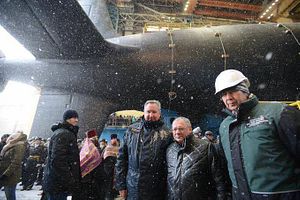The Russian Navy has launched its first Project 885-M Yasen M-class multipurpose attack nuclear-powered submarine (SSN), christened Kazan, at the Sevmash shipyards in Severodvinsk, a port city on Russia’s White Sea in Arkhangelsk Oblast, on March 31.
Under construction at the Sevmash shipyards since 2009, the Kazan is the second Yasen-class SSN launched by the Russian Navy and the first upgraded Yasen M-class boat fitted with improved sensors and weapons systems.
The new boat is reportedly equipped with eight vertical silos for submarine-launched cruise missiles and ten torpedo tubes. The improved Yasen M-class submarine is expected to be quieter than the original Yasen-class SSN and has been built with low magnetic steel to reduce its magnetic signature.
However, while the improved Yasen M-class appears to be the quietest nuclear-powered submarine ever to enter service with the Russian Navy, the class is purportedly not equal to the United States Navy’s new Virginia-class attack subs, and is more on par with older Seawolf-class boats, built by the U.S. Navy from 1989 to 2005.
Judging from publicly available sources, the Yasen M-class is a formidable weapons platform armed, among other things, with the 3M-54 Kalibr supersonic cruise missile available in land-attack, anti-ship, and anti-submarine variants, and a new deep-water torpedo, an improved variant of the 533-milimeter Fizik-1 homing torpedo (See: “Russia’s Deadliest Subs to Receive New Heat-Seeking Torpedos”).
Despite the recent launch of the Kazan and the official goal of building seven improved Yasen M-class boats by 2023, it is unlikely that Russia’s shipbuilding industry “will complete more than two additional Yasen M-class boats by 2020 due to budgetary constraints — the subs are among the most expensive pieces of military hardware ever built by Russia,” I reported earlier in the year. As I noted elsewhere:
The 13,800-ton, 390-foot long and highly automated Yasen-class of Russian attack submarines was supposed to replace older Soviet-era multi-purpose nuclear submarine models by 2020.
Yet, the exorbitant costs of the submarines — estimated to be twice as much as the new Borei-class SSBNs – has so far led only to the commissioning of one out of eight SSNs (…).
In addition, I explained in January:
One of the reasons for the excessive costs is untried new technology installed aboard the Yasen M-class. For example, Yasen M boats are allegedly equipped with a new spherical sonar, dubbed MGK-600 Irtysh-Amfora, and a new fourth-generation nuclear reactor, which reportedly provides a maximum underwater speed of 35 knots and a surface speed of 20 knots.
Nevertheless, the boat’s purported stealthiness, in combination with its deep diving capabilities, will most likely constitute a genuine threat to Western subs and U.S. carrier strike groups.
“The launch of an advanced multi-role submarine of the improved project Yasen M is quite an event for the whole of the country, its armed forces, and its Navy,” the Russian Navy commander-in-chief, Admiral Vladimir Korolyov, said during the March 31 launch ceremony, according to TASS news agency. “We are working together on a plan approved by the government. We are in the process of creating a submarine group capable of coping with missions around the world and maintaining Russia’s security.”
Only one Yasen-class attack submarine, the K-329 Severodvinsk, has so far been commissioned into the Russian Navy. Laid down in 1993, the Severodvinsk has been undergoing sea trials since 2011 and it is unclear whether the boat is operational or not. There are currently five more Yasen M-class subs under construction at the Sevmash Shipyard. The Kazan is expected to be handed over to the Russian Navy’s Northern Fleet in 2018.































